Energy Secretary Jennifer Granholm on Friday announced her department’s seven choices for Regional Clean Hydrogen Hubs. The government is investing $7 billion in the hubs to leverage a total of $50 billion in public-private partnerships. That is meant to deliver a hefty giddy-up to a nascent industry the administration says will ultimately employ tens of thousands of workers and be of major assistance in reaching net zero carbon emissions.
In a statement, the White House said, “Collectively, the hubs aim to produce more than three million metric tons of clean hydrogen per year, thereby achieving nearly one third of the 2030 U.S. clean hydrogen production goal. Together, the seven Hydrogen Hubs will eliminate 25 million metric tons of carbon dioxide emissions from end uses each year—an amount roughly equivalent to combined annual emissions of over 5.5 million gasoline-powered cars. The nearly $50 billion investment is one of the largest investments in clean manufacturing and jobs in history.”
Another environmental victory, right? A trifecta, in fact: good jobs, a new, specialized clean industry, and less greenhouse gas. Not so fast, say critics, some gentle, some not.
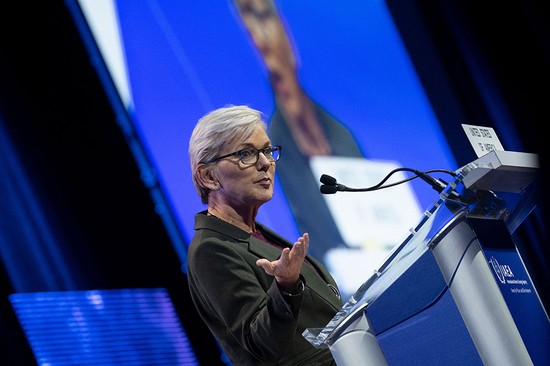
Energy Secretary Jennifer Granholm
For instance, Revolving Door Project Senior Researcher Hannah Story Brown said: “Any hope that the Department of Energy was going to send a clear, strong signal that hydrogen needs to be produced by renewable energy in order to be ‘clean’ was thoroughly extinguished on Friday. A majority of the selected projects intend to produce hydrogen from fossil fuels and rely on unproven carbon capture and storage technology to clean up the carbon dioxide generated as the main byproduct of the chemical process that yields hydrogen from natural gas. The Energy Department has already poured more than a billion federal dollars into failed carbon capture initiatives which made no discernible dent in the nation’s massive emissions. Why should we expect this latest contrivance to lead to real success where all of its predecessors have failed?”
Julie McNamara, deputy policy director of the Climate and Energy Program at the Union of Concerned Scientists, said "billions of taxpayer dollars are at risk of perpetuating fossil fuel industry injustices and harms while subsidizing fossil fuel greenwashing."
And though the Sierra Club supports the hydrogen hubs. executive director Ben Jealous warned after the announcement that "the fossil fuel industry is working to continue our nation's reliance on fossil fuels by any means necessary—and hydrogen offers yet another possible inroad for Big Oil and Gas to lock in polluting and noneconomic uses of gas for decades to come. Decision-makers in the administration and at the local level must be wary of these attempts and ensure as much hydrogen-specific funding as possible goes to green hydrogen and its most efficient end uses to ensure this investment actually addresses climate change.”
From the 79 applicants, the Department of Energy (DOE) chose the Mid-Atlantic Hydrogen Hub, Appalachian Hydrogen Hub, California Hydrogen Hub, Gulf Coast Hydrogen Hub, Heartland Hydrogen Hub, Midwest Hydrogen Hub and Pacific Northwest Hydrogen Hub.
The idea is to spur production of low or no-carbon hydrogen in order to ditch carbon-intensive processes for making steel, cement, agricultural chemicals and fertilizer as well as provide a substitute for aviation and shipping fuels. Currently, hydrogen is labeled in a rainbow of colors: gray, blue, green, pink, even turquoise. The vast majority of the 10 milion metric tons the United States now produces annually is called “gray hydrogen.” It’s derived from natural gas without any carbon capture and is a strong greenhouse gas emitter. “Blue hydrogen” is made from gas with carbon capture. “Green hydrogen” is made from renewable energy sources and electrolyzers. “Pink hydrogen” is made with nuclear power and electrolyzers, although the U.S. produces less than a metric ton that way currently.
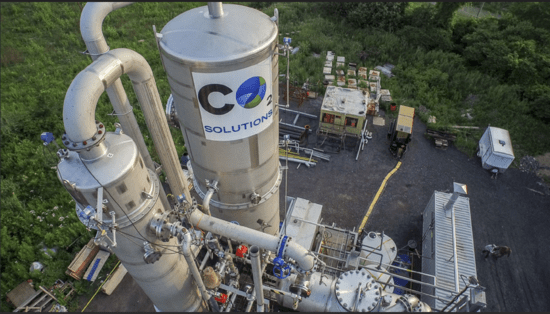
CO2 Solutions’ carbon capture unit in Salaberry-de-Valleyfield, Québec.
The regional hubs still have to negotiate many details of their plans with the DOE, so the exact mix of methods may change depending on which projects make it through that process. The Midwest hub, for example, told E&E News it is going for an “all-of-the-above” strategy and has projects for green, blue, and pink hydrogen.
From the critics’ standpoint, there’s a serious problem. The Bipartisan Infrastructure Act passed two years ago created the hub program and included a mandate that one hub produce blue hydrogen. But five of the seven partnerships the administration announced plan to make big investments in blue hydrogen.
Jill Tauber, Vice President of Litigation for Climate & Energy at Earthjustice, responded in a statement: “Hydrogen can be a clean energy solution, or it can drive us deeper into the climate crisis and hurt communities. Hydrogen produced from fossil fuels is not a solution — whatever the color. Green hydrogen that is powered by new renewable resources can play an important role cleaning up what we cannot electrify, like steel manufacturing. Strong policies and smart, targeted investments can ensure the right path.”
In a thorough and nuanced article on the subject at Canary Media, Jeff St. John writes:
Other critics have also weighed in. For instance, the Ohio River Valley Institute responded to plans to provide $925 million to the Appalachian Regional Clean Hydrogen Hub. It’s beloved by Sen. Joe Manchin because it uses fossil fuel plus carbon capture to make blue hydrogen:
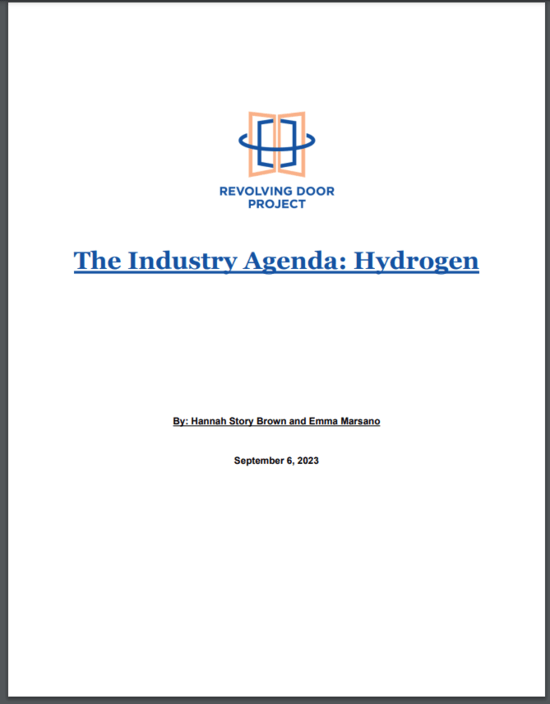
Last month the Revolving Door Project published a 34-page scrutiny of the entities involved in making hydrogen production into a major affair. Among their litany of criticisms:
Related reading:
Tne Biden administration has vowed to cut greenhouse gas emissions in the electricity-generating sector of the economy by 80% over what it was in 2005 by 2030. One big obstacle, according to the Sierra Club’s report, is that “many utilities are unprepared” to comply. Here’s an excerpt:
Delay in planning and acting in this matter is just another form of climate science denial.
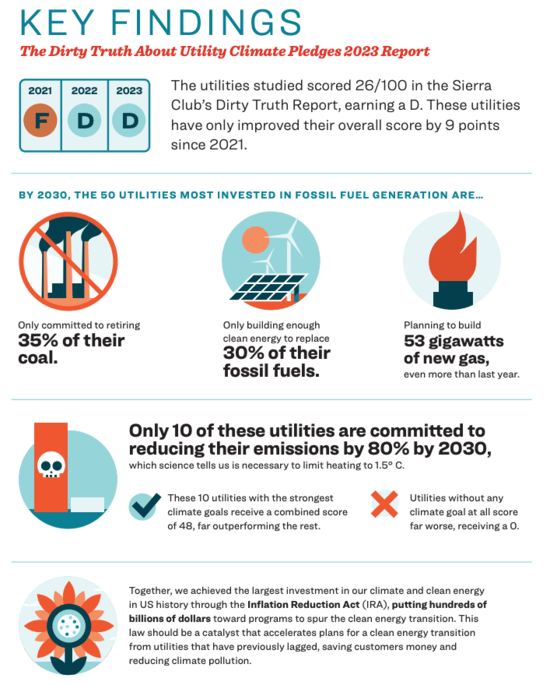
Farmers Want Climate Resilience, but GOP Lawmakers Want to Redirect Billions in Conservation Funds by Wendy Johnson at Civil Eats. It may be months before lawmakers can agree on a new farm bill. And as their negotiations set the stage for the next five years of American agriculture, it can feel to farmers like our future is in their hands. Despite the ongoing droughts, floods, heat waves, and fires—and their ensuing costs to taxpayers—there’s still no consensus among lawmakers about the value of helping farmers achieve resilience in the face of climate change. Many of us, however, are taking matters into our own hands. On the parts of my farm where I’ve been able to plant trees and perennial plants and grasses, that deep-rooted living cover is still providing a lifeline to moisture and minerals. I’ve been slowly expanding the land on which I’m using these conservation practices, and I’ve witnessed how resilient the area has become to unpleasant climate extremes.

Farmer Hannah Bernhardt bought and converted a piece of degraded land with no infrastructure into a highly diversified, grass-based farm with the help of conservation funding.
Plant Milk Is Better for Us and the Climate. So Why Do We Subsidize Dairy? by Julia Métraux at Mother Jones. Plant-based milks, a multibillion-dollar global market, aren’t just good for the lactose intolerant: They’re also better for the climate. Dairy cows belch a lot of methane and contribute at least 7% of U.S. methane output, equivalent to emissions of 10 million cars. Cattle need a lot of room to graze, too: Plant-based milks use about a 10th as much land to produce the same quantity of milk. And it takes almost a thousand gallons of water to manufacture a gallon of dairy milk—four times the water cost of alt-milk from oats or soy. But if climate concerns push us toward the alt-milk aisle, dairy still has price on its side. Even though plant-based milks are generally much less resource-intensive, they’re often more expensive. Dairy’s affordability edge relies on the industry’s ability to produce “at larger volumes, which drives down the cost per carton.” American demand for milk alternatives, though expected to grow by 10% a year through 2030, can’t beat those economies of scale. What else contributes to cow milk’s dominance? Dairy farmers are “political favorites,” says agricultural economist Daniel Sumner. He says that in addition to support like the “Dairy Checkoff,” a joint government-industry program to promote milk products (including the “Got Milk?” campaign), they’ve long raked in direct subsidies currently worth around $1 billion a year.
After Oil—Chevron’s refinery in Richmond, Calif., is a major polluter. Can the activists trying to shut it down convince its 3,000 workers they’re on the same side? By Madeline Ostrander at The Nation. If the U.S. is ever going to take climate change seriously, communities that depend on the oil industry will need to have difficult conversations about what comes next for the refineries in their midst. In 2020, the California-based environmental justice organization Communities for a Better Environment (CBE) published a detailed analysis by Greg Karras called “Decommissioning California Refineries.” Karras concluded that even with California’s aggressive measures to push electric cars and renewables, the state wouldn’t reach its climate goals unless it significantly cut back on oil processing at refineries. But this has been a thorny issue in California, where hundreds of thousands of jobs still rely on oil and gas. Both the oil and gas sector and some state agencies have argued that refineries could meet some of their emissions-slashing goals through carbon capture and storage, a largely unproven technology that is supposed to stash carbon dioxide underground instead of sending it into the atmosphere. Environmental justice activists oppose measures like this as well as other efforts to repurpose a refinery to produce alternative fuels. They argue that any fuel production at a refinery burdens their communities with an intolerable level of risk, whether from pollution or industrial accidents or both. And these groups do not trust the oil industry to protect health and safety. So CBE (which organizes in Richmond), the RPA, and other allied activist organizations decided they should take action and started an audacious conversation about planning for the closure of the Chevron refinery. .

Halla Hrund Logadóttir
What's the deal with Iceland? A conversation with Halla Hrund Logadóttir of Iceland's National Energy Authority conducted by David Roberts at his Volts substack. Iceland is an island just south of the Arctic Circle, perched directly atop a rift where two tectonic plates are drifting apart, exposing the magma below. It is a small country (physically about the size of Kentucky, with a population a little larger than Cleveland, Ohio’s), but what it lacks in size it makes up for in drama. It is a land of glaciers and volcanos, ice and fire, wind and rain and snow — and deep heat that makes them bearable. I was there for four days last week, meeting with sustainability-related businesses, hearing about everything from micro-algae to grid monitoring to carbon recycling to using 100 percent of the fish. There’s an incredible amount of innovation going on there, and to my unending delight, a great deal of that innovation is in some way or another in a symbiotic relationship with geothermal, the heat and power that Icelanders pull from underground. Iceland’s electricity is entirely carbon-free — roughly 70 percent hydropower and 30 percent geothermal — and so is its heating, 90 percent of which is geothermal. Overall, 85 percent of its energy consumption is carbon-free, and it is aiming for 100 percent by 2040.
Low Key Green: Pueblo is a world-class model for the clean-energy economy envisioned in the Inflation Reduction Act. But its residents may not feel it by Chase Woodruff. Ruben Peña welcomes visitors from all over the world to the sprawling railroad testing facility he helps manage on the shortgrass prairie of eastern Pueblo County. “Last week, I hosted people from the Czech Republic. This week, we have a whole bunch of people from Switzerland,” said Peña, an executive at ENSCO, the contractor that operates the Transportation Technology Center (TTC) on behalf of the Federal Railroad Administration. “We had a contingent from Brazil two weeks ago. They all stay in Pueblo, and I feed them sloppers,” he added, referring to a local specialty—an open-faced cheeseburger smothered in Pueblo green chile.But while Peña is acquainting train engineers and government functionaries from across the globe with the local cuisine, he said, few people in Pueblo and other towns along Colorado’s Front Range are familiar with the TTC, where everything from electric trams and next-gen Acela trains to hydrogen-powered prototypes and highly classified government vehicles are put through their paces on 42 miles of test track. “When I talk to people in Colorado, they don’t know,” Peña said. “Not even in Pueblo.”
As California Gets Drier, Solar Panels Could Help Farms Save Water by Anna Guth at Civil Eats. Agrivoltaics—or on-farm solar arrays—are still rare in California, but experts say the shade they provide could be a game-changer in a state where many farms are struggling to plan for a future with limited groundwater. Satellite imagery of Topaz Solar Farm, a massive solar installation inland from San Luis Obispo in Central California, depicts an oasis of blue panels surrounded by sun-scorched earth. The images do not capture, however, the thousands of sheep hard at work under the panels, eating the non-native grasses and reducing the threat of wildfire. The operation benefits everyone involved: Sheep farmer Frankie Iturriria gets paid for his time, the collaborating rangeland researchers are breaking ground, and the landowner BHE Renewables can maintain the property with sheep, which have less impact and are more cost-effective than mowers or other livestock. But the farm is one of relatively few examples of agrivoltaics—or combined agriculture and photovoltaic array systems—on private land in California, where the technology has been surprisingly slow to gain visibility and traction. “I see it as a key player for maintaining food security for the 10 billion people who will be inhabiting this planet by 2050.” Scientists, farmers, and advocates agree that one of the biggest barriers to rolling out agrivoltaics in California—the national leader in solar energy, agricultural production, and even on-farm solar—is a need for more state-specific research. Internationally, many countries in Europe and Asia are ahead of the U.S. as far as implementation; and within the U.S., the East Coast has largely been leading the charge.
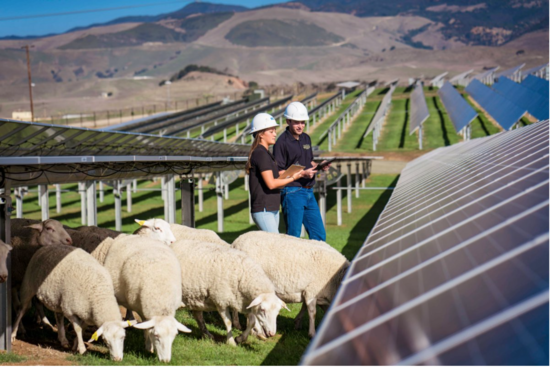
Sheep grazing at the Cal Poly Gold Tree Solar Farm site.
Virginia solar program delivers clean energy to elderly, low-income households: A three-year pilot spurred by 2019 legislation, the Dominion Energy program offers weatherization services and solar panels to qualified customers free of charge. By Elizabeth MacGowan at Energy News Network. Everett Brubaker, based in the nearby Shenandoah Valley city of Harrisonburg, is an outreach specialist on the Energy Solutions team at Community Housing Partners. His employer is the largest of roughly a dozen nonprofits statewide qualified to perform weatherization services.Linking homeowners who live paycheck-to-paycheck to a suite of age- and income-qualifying programs is the bread and butter of that network. Those connections are all about enhancing affordability, adding value and ensuring residents are safe and healthy in their homes. However, that holistic approach falls flat, Brubaker said, if he doesn’t devote time to building relationships with people who have every right to be wary of anything promoted as free. “For my Aunt Rachel, that little 5-kilowatt system is a gamechanger,” he said. “But seniors are inundated with scams about solar so it’s nearly impossible to sift through what’s legitimate and what isn’t. It’s important that there be comfort and trust.”
Most Utilities That Pledge “Net Zero by 2050” Are Doing Little to Achieve That Goal by Jonathan Hahn at Sierra. Like many utilities, Southern Company, the second-largest gas and electric company in the United States, has a “net zero” climate pledge. A page on its website features gleaming solar panels pointing toward a blue sky, where the utility acknowledges the importance of the Paris Agreement. “Key to Southern Company’s environmental initiatives,” the company offers, “is a net-zero transition focusing on greenhouse gas emissions reductions, decarbonization, and a Just Transition.” Apparently, Southern Company’s green energy keywords haven’t translated into actual policy. All the company’s subsidiaries—Alabama Power, Georgia Power, and Mississippi Power, which together serve 9 million customers— get an F on a national report card tracking the progress of their plans to transition away from fossil fuels, according to The Dirty Truth About Utility Climate Pledges: 2023 Annual Report. The analysis examines 77 utilities across the country and their plans (if any) to retire coal plants and stop the construction of new fracked gas plants. The score card also measures how successful utilities have been in replacing high-polluting sources of energy with clean sources such as wind and solar.
Wildlife across the globe are polluted with flame retardants: Map by the Environmental Health News staff. Wildlife on every continent are contaminated with harmful flame-retardant chemicals, including some endangered species such as killer whales, northern sea otters, red pandas and chimpanzees, according to a new map that tracks peer-reviewed studies from around the world. Flame-retardants — used in products like furniture, building materials, electronics and cars to meet flammability rules — can leach out and get into the environment, and eventually wildlife and people. Researchers have found both phased-out flame-retardants like polychlorinated biphenyls (PCBs) and polybrominated diphenyl ethers (PBDEs) and replacement chemicals like chlorinated paraffins and organophosphate flame-retardants in wildlife. Flame-retardant exposure is linked to a host of health issues including decreased fertility, certain cancers, endocrine disruption, impaired fetal and child development, and immune system impacts.
The Slow Extraction of Lead Water Pipes • Amazon now has 10,000 Rivian electric delivery vans in service • 'A Wake-Up Call': 21 Species Declared Extinct by US • In wildfire-prone areas, homeowners are learning they’re uninsurable • Study: The best way to restore ecosystems is to listen to Indigenous peoples • Seaweed was common food in Europe for thousands of years, researchers find • Electric Grids Are a Hidden Weak Spot in World’s Climate Plans, Report Warns • One key step in the energy transition? No new gas lines • Toxic Flame Retardants Contaminating Wildlife on Every Continent: Analysis • A Severe Drought Pushes an Imperiled Amazon to the Brink
In a statement, the White House said, “Collectively, the hubs aim to produce more than three million metric tons of clean hydrogen per year, thereby achieving nearly one third of the 2030 U.S. clean hydrogen production goal. Together, the seven Hydrogen Hubs will eliminate 25 million metric tons of carbon dioxide emissions from end uses each year—an amount roughly equivalent to combined annual emissions of over 5.5 million gasoline-powered cars. The nearly $50 billion investment is one of the largest investments in clean manufacturing and jobs in history.”
Another environmental victory, right? A trifecta, in fact: good jobs, a new, specialized clean industry, and less greenhouse gas. Not so fast, say critics, some gentle, some not.

Energy Secretary Jennifer Granholm
For instance, Revolving Door Project Senior Researcher Hannah Story Brown said: “Any hope that the Department of Energy was going to send a clear, strong signal that hydrogen needs to be produced by renewable energy in order to be ‘clean’ was thoroughly extinguished on Friday. A majority of the selected projects intend to produce hydrogen from fossil fuels and rely on unproven carbon capture and storage technology to clean up the carbon dioxide generated as the main byproduct of the chemical process that yields hydrogen from natural gas. The Energy Department has already poured more than a billion federal dollars into failed carbon capture initiatives which made no discernible dent in the nation’s massive emissions. Why should we expect this latest contrivance to lead to real success where all of its predecessors have failed?”
Julie McNamara, deputy policy director of the Climate and Energy Program at the Union of Concerned Scientists, said "billions of taxpayer dollars are at risk of perpetuating fossil fuel industry injustices and harms while subsidizing fossil fuel greenwashing."
And though the Sierra Club supports the hydrogen hubs. executive director Ben Jealous warned after the announcement that "the fossil fuel industry is working to continue our nation's reliance on fossil fuels by any means necessary—and hydrogen offers yet another possible inroad for Big Oil and Gas to lock in polluting and noneconomic uses of gas for decades to come. Decision-makers in the administration and at the local level must be wary of these attempts and ensure as much hydrogen-specific funding as possible goes to green hydrogen and its most efficient end uses to ensure this investment actually addresses climate change.”
From the 79 applicants, the Department of Energy (DOE) chose the Mid-Atlantic Hydrogen Hub, Appalachian Hydrogen Hub, California Hydrogen Hub, Gulf Coast Hydrogen Hub, Heartland Hydrogen Hub, Midwest Hydrogen Hub and Pacific Northwest Hydrogen Hub.
The idea is to spur production of low or no-carbon hydrogen in order to ditch carbon-intensive processes for making steel, cement, agricultural chemicals and fertilizer as well as provide a substitute for aviation and shipping fuels. Currently, hydrogen is labeled in a rainbow of colors: gray, blue, green, pink, even turquoise. The vast majority of the 10 milion metric tons the United States now produces annually is called “gray hydrogen.” It’s derived from natural gas without any carbon capture and is a strong greenhouse gas emitter. “Blue hydrogen” is made from gas with carbon capture. “Green hydrogen” is made from renewable energy sources and electrolyzers. “Pink hydrogen” is made with nuclear power and electrolyzers, although the U.S. produces less than a metric ton that way currently.

CO2 Solutions’ carbon capture unit in Salaberry-de-Valleyfield, Québec.
The regional hubs still have to negotiate many details of their plans with the DOE, so the exact mix of methods may change depending on which projects make it through that process. The Midwest hub, for example, told E&E News it is going for an “all-of-the-above” strategy and has projects for green, blue, and pink hydrogen.
From the critics’ standpoint, there’s a serious problem. The Bipartisan Infrastructure Act passed two years ago created the hub program and included a mandate that one hub produce blue hydrogen. But five of the seven partnerships the administration announced plan to make big investments in blue hydrogen.
Jill Tauber, Vice President of Litigation for Climate & Energy at Earthjustice, responded in a statement: “Hydrogen can be a clean energy solution, or it can drive us deeper into the climate crisis and hurt communities. Hydrogen produced from fossil fuels is not a solution — whatever the color. Green hydrogen that is powered by new renewable resources can play an important role cleaning up what we cannot electrify, like steel manufacturing. Strong policies and smart, targeted investments can ensure the right path.”
In a thorough and nuanced article on the subject at Canary Media, Jeff St. John writes:
“They [fossil fuel forces] still claim, sometimes, that blue hydrogen is low-emissions or zero-emissions,” said Robert Howarth, professor of ecology and environmental biology at Cornell University. But there isn’t “anything in the peer-reviewed literature to support those claims at all.”
After spending several years searching for evidence, Howarth teamed up with Mark Z. Jacobson, a professor of civil and environmental engineering at Stanford University, to conduct their own research. The results, published in August 2021, indicate that in almost all cases, blue hydrogen ends up emitting more greenhouse gases compared to simply burning fossil gas directly for heating and industrial processes.
Several factors contribute to this counterintuitive result, Howarth said. The first is that wells, pipelines, compressor stations and other gas-delivery infrastructure leak methane, the primary component of fossil gas. Methane is a relatively short-lived but powerful greenhouse gas, with more than 80 times the global warming impact of carbon dioxide over a 20-year period.
“You can’t use natural gas without fugitive methane,” Howarth said. “It may not be a huge amount, but it has a huge climate impact.”
Other critics have also weighed in. For instance, the Ohio River Valley Institute responded to plans to provide $925 million to the Appalachian Regional Clean Hydrogen Hub. It’s beloved by Sen. Joe Manchin because it uses fossil fuel plus carbon capture to make blue hydrogen:
Research shows the carbon capture technology underlying ARCH2’s hydrogen hub proposal, which spans parts of West Virginia, southeastern Ohio, southwestern Pennsylvania, and eastern Kentucky, is a cost-prohibitive and ultimately ineffective means of decarbonization.
First, the technology is unproven at scale. Carbon capture has been under development for decades and received more than 15 years of federal tax incentives, yet the technology is still not used in any large American power plant. Numerous carbon capture retrofits and pilot projects have been canceled or have failed. Moreover, state regulatory agencies lack the bandwidth and technical expertise to properly permit and monitor the unprecedented network of carbon transportation and storage infrastructure that hub development would require.
The technology itself has also failed to reliably reduce carbon emissions in the power sector. Real-world carbon capture rates are far below Department of Energy targets and even operators’ claims, according to IEEFA research.

Last month the Revolving Door Project published a 34-page scrutiny of the entities involved in making hydrogen production into a major affair. Among their litany of criticisms:
All methods of hydrogen production require varying but massive quantities of fresh water, which raises serious environmental concerns for hydrogen production in water-stressed regions—and in an increasingly water-stressed world. Food and Water Watch estimated that “the DOE’s goal of 50 [million metric tons] of hydrogen production annually in 2050 would require up to one trillion gallons of freshwater (or 4.6 trillion gallons of seawater), which is equivalent to over 34 million Americans' annual home water use.”
One trillion gallons is the amount of water in Florida’s so-called “inland sea” Lake Okeechobee, which is three-quarters the size of Rhode Island.The FWW researchers also pointed out that “many of the proposed hydrogen projects vying for federal funds are in areas currently experiencing historic drought compounded by climate change,” including in California and New Mexico. They conclude by stressing that “a shift to hydrogen energy that entrenches fossil fuel infrastructure would come at the cost of a renewable energy future that has a small water and carbon footprint.”
Related reading:
- For hydrogen to be a climate solution, leaks must be tackled
- Hydrogen Is Big Oil’s Last Grand Scam
- Hydrogen: Future of Clean Energy or a False Solution?
- What is green hydrogen and why do we need it? An expert explains
- The hope and hype of hydrogen
WEEKLY ECO-VIDEO
YouTube VideoRESOURCES
- Plastics & Environmental Justice: What's Next for the Global Treaty? In this Nov. 1, 2023, webinar, Yvette Arellano of Fenceline Watch will share the organization’s work to protect communities in and near Houston, Texas, by reducing exposure to chemicals released during the plastics production cycle.
- 7 myths about fuels and electric trucks from the oil and gas industry. The European Union is currently revising its CO2 standards for heavy-duty vehicles (HDVs). This regulation will irreversibly cut the trucking sector’s dependence on diesel. As a result, the oil and gas industry is eager to create room for so-called “alternative fuels” in the new law, in spite of the opposition from mos ttruckmakers. To make their case, the industry has been spreading myths to shed a positive light on biofuels and synthetic fuels and to discredit electric trucks.
- Bait to Plate is an interactive tool of The Outlaw Ocean Project that traces seafood from ships and processing plants to downstream brands and consumers, including what is known about possible crimes or other types of concerns within these supply chains.
GREEN BRIEF
SIERRA CLUB REPORT: THE DIRTY TRUTH ABOUT UTILITY CLIMATE PLEDGES
Tne Biden administration has vowed to cut greenhouse gas emissions in the electricity-generating sector of the economy by 80% over what it was in 2005 by 2030. One big obstacle, according to the Sierra Club’s report, is that “many utilities are unprepared” to comply. Here’s an excerpt:
In this report, we evaluate the plans of 77 utility companies owned by the 50 parent companies most invested in coaland gas to see if they are successfully preparing for the clean transition. Utilities are scored in three categories: (1) plans to retire existing coal generation, (2) plans to build new gas capacity, and (3) plans to build new wind and solar generation. Companies gain points for retiring coal and building clean energy, and lose points for expanding gas. Overall, we found that the plans companies release do not align with what is needed to transition away from fossil fuels. Collectively, these companies scored only 26 points out of 100, earning a D. Since our last report in 2022, scores have improved by only 5 points. Compared to the first year of this report, two and a half years ago, utilities’ scores have only improved 9 points. Even though we are already well into this pivotal decade for urgent action, companies continue to lag in their plans for a transition to clean energy. With recently passed legislation, including the IRA [Inflation Reduction Act], clean energy is the cheapest option by far. Continuing to delay is unacceptable.
Delay in planning and acting in this matter is just another form of climate science denial.

ECOPINIONS
Farmers Want Climate Resilience, but GOP Lawmakers Want to Redirect Billions in Conservation Funds by Wendy Johnson at Civil Eats. It may be months before lawmakers can agree on a new farm bill. And as their negotiations set the stage for the next five years of American agriculture, it can feel to farmers like our future is in their hands. Despite the ongoing droughts, floods, heat waves, and fires—and their ensuing costs to taxpayers—there’s still no consensus among lawmakers about the value of helping farmers achieve resilience in the face of climate change. Many of us, however, are taking matters into our own hands. On the parts of my farm where I’ve been able to plant trees and perennial plants and grasses, that deep-rooted living cover is still providing a lifeline to moisture and minerals. I’ve been slowly expanding the land on which I’m using these conservation practices, and I’ve witnessed how resilient the area has become to unpleasant climate extremes.

Farmer Hannah Bernhardt bought and converted a piece of degraded land with no infrastructure into a highly diversified, grass-based farm with the help of conservation funding.
Plant Milk Is Better for Us and the Climate. So Why Do We Subsidize Dairy? by Julia Métraux at Mother Jones. Plant-based milks, a multibillion-dollar global market, aren’t just good for the lactose intolerant: They’re also better for the climate. Dairy cows belch a lot of methane and contribute at least 7% of U.S. methane output, equivalent to emissions of 10 million cars. Cattle need a lot of room to graze, too: Plant-based milks use about a 10th as much land to produce the same quantity of milk. And it takes almost a thousand gallons of water to manufacture a gallon of dairy milk—four times the water cost of alt-milk from oats or soy. But if climate concerns push us toward the alt-milk aisle, dairy still has price on its side. Even though plant-based milks are generally much less resource-intensive, they’re often more expensive. Dairy’s affordability edge relies on the industry’s ability to produce “at larger volumes, which drives down the cost per carton.” American demand for milk alternatives, though expected to grow by 10% a year through 2030, can’t beat those economies of scale. What else contributes to cow milk’s dominance? Dairy farmers are “political favorites,” says agricultural economist Daniel Sumner. He says that in addition to support like the “Dairy Checkoff,” a joint government-industry program to promote milk products (including the “Got Milk?” campaign), they’ve long raked in direct subsidies currently worth around $1 billion a year.
After Oil—Chevron’s refinery in Richmond, Calif., is a major polluter. Can the activists trying to shut it down convince its 3,000 workers they’re on the same side? By Madeline Ostrander at The Nation. If the U.S. is ever going to take climate change seriously, communities that depend on the oil industry will need to have difficult conversations about what comes next for the refineries in their midst. In 2020, the California-based environmental justice organization Communities for a Better Environment (CBE) published a detailed analysis by Greg Karras called “Decommissioning California Refineries.” Karras concluded that even with California’s aggressive measures to push electric cars and renewables, the state wouldn’t reach its climate goals unless it significantly cut back on oil processing at refineries. But this has been a thorny issue in California, where hundreds of thousands of jobs still rely on oil and gas. Both the oil and gas sector and some state agencies have argued that refineries could meet some of their emissions-slashing goals through carbon capture and storage, a largely unproven technology that is supposed to stash carbon dioxide underground instead of sending it into the atmosphere. Environmental justice activists oppose measures like this as well as other efforts to repurpose a refinery to produce alternative fuels. They argue that any fuel production at a refinery burdens their communities with an intolerable level of risk, whether from pollution or industrial accidents or both. And these groups do not trust the oil industry to protect health and safety. So CBE (which organizes in Richmond), the RPA, and other allied activist organizations decided they should take action and started an audacious conversation about planning for the closure of the Chevron refinery. .
ECO-TWXXT
Earth Stopped Getting Greener 20 Years Ago The world is gradually becoming less green, scientists have found. Plant growth is declining all over the planet, and new research links the phenomenon to decreasing moisture in the air—a consequence of climate change. The study… pic.twitter.com/hXNp179g2Q
— David Ullrich (@DavidUllrich202) October 18, 2023
HALF A DOZEN OTHER THINGS TO READ (OR LISTEN TO)

Halla Hrund Logadóttir
What's the deal with Iceland? A conversation with Halla Hrund Logadóttir of Iceland's National Energy Authority conducted by David Roberts at his Volts substack. Iceland is an island just south of the Arctic Circle, perched directly atop a rift where two tectonic plates are drifting apart, exposing the magma below. It is a small country (physically about the size of Kentucky, with a population a little larger than Cleveland, Ohio’s), but what it lacks in size it makes up for in drama. It is a land of glaciers and volcanos, ice and fire, wind and rain and snow — and deep heat that makes them bearable. I was there for four days last week, meeting with sustainability-related businesses, hearing about everything from micro-algae to grid monitoring to carbon recycling to using 100 percent of the fish. There’s an incredible amount of innovation going on there, and to my unending delight, a great deal of that innovation is in some way or another in a symbiotic relationship with geothermal, the heat and power that Icelanders pull from underground. Iceland’s electricity is entirely carbon-free — roughly 70 percent hydropower and 30 percent geothermal — and so is its heating, 90 percent of which is geothermal. Overall, 85 percent of its energy consumption is carbon-free, and it is aiming for 100 percent by 2040.
Low Key Green: Pueblo is a world-class model for the clean-energy economy envisioned in the Inflation Reduction Act. But its residents may not feel it by Chase Woodruff. Ruben Peña welcomes visitors from all over the world to the sprawling railroad testing facility he helps manage on the shortgrass prairie of eastern Pueblo County. “Last week, I hosted people from the Czech Republic. This week, we have a whole bunch of people from Switzerland,” said Peña, an executive at ENSCO, the contractor that operates the Transportation Technology Center (TTC) on behalf of the Federal Railroad Administration. “We had a contingent from Brazil two weeks ago. They all stay in Pueblo, and I feed them sloppers,” he added, referring to a local specialty—an open-faced cheeseburger smothered in Pueblo green chile.But while Peña is acquainting train engineers and government functionaries from across the globe with the local cuisine, he said, few people in Pueblo and other towns along Colorado’s Front Range are familiar with the TTC, where everything from electric trams and next-gen Acela trains to hydrogen-powered prototypes and highly classified government vehicles are put through their paces on 42 miles of test track. “When I talk to people in Colorado, they don’t know,” Peña said. “Not even in Pueblo.”
As California Gets Drier, Solar Panels Could Help Farms Save Water by Anna Guth at Civil Eats. Agrivoltaics—or on-farm solar arrays—are still rare in California, but experts say the shade they provide could be a game-changer in a state where many farms are struggling to plan for a future with limited groundwater. Satellite imagery of Topaz Solar Farm, a massive solar installation inland from San Luis Obispo in Central California, depicts an oasis of blue panels surrounded by sun-scorched earth. The images do not capture, however, the thousands of sheep hard at work under the panels, eating the non-native grasses and reducing the threat of wildfire. The operation benefits everyone involved: Sheep farmer Frankie Iturriria gets paid for his time, the collaborating rangeland researchers are breaking ground, and the landowner BHE Renewables can maintain the property with sheep, which have less impact and are more cost-effective than mowers or other livestock. But the farm is one of relatively few examples of agrivoltaics—or combined agriculture and photovoltaic array systems—on private land in California, where the technology has been surprisingly slow to gain visibility and traction. “I see it as a key player for maintaining food security for the 10 billion people who will be inhabiting this planet by 2050.” Scientists, farmers, and advocates agree that one of the biggest barriers to rolling out agrivoltaics in California—the national leader in solar energy, agricultural production, and even on-farm solar—is a need for more state-specific research. Internationally, many countries in Europe and Asia are ahead of the U.S. as far as implementation; and within the U.S., the East Coast has largely been leading the charge.

Sheep grazing at the Cal Poly Gold Tree Solar Farm site.
Virginia solar program delivers clean energy to elderly, low-income households: A three-year pilot spurred by 2019 legislation, the Dominion Energy program offers weatherization services and solar panels to qualified customers free of charge. By Elizabeth MacGowan at Energy News Network. Everett Brubaker, based in the nearby Shenandoah Valley city of Harrisonburg, is an outreach specialist on the Energy Solutions team at Community Housing Partners. His employer is the largest of roughly a dozen nonprofits statewide qualified to perform weatherization services.Linking homeowners who live paycheck-to-paycheck to a suite of age- and income-qualifying programs is the bread and butter of that network. Those connections are all about enhancing affordability, adding value and ensuring residents are safe and healthy in their homes. However, that holistic approach falls flat, Brubaker said, if he doesn’t devote time to building relationships with people who have every right to be wary of anything promoted as free. “For my Aunt Rachel, that little 5-kilowatt system is a gamechanger,” he said. “But seniors are inundated with scams about solar so it’s nearly impossible to sift through what’s legitimate and what isn’t. It’s important that there be comfort and trust.”
Most Utilities That Pledge “Net Zero by 2050” Are Doing Little to Achieve That Goal by Jonathan Hahn at Sierra. Like many utilities, Southern Company, the second-largest gas and electric company in the United States, has a “net zero” climate pledge. A page on its website features gleaming solar panels pointing toward a blue sky, where the utility acknowledges the importance of the Paris Agreement. “Key to Southern Company’s environmental initiatives,” the company offers, “is a net-zero transition focusing on greenhouse gas emissions reductions, decarbonization, and a Just Transition.” Apparently, Southern Company’s green energy keywords haven’t translated into actual policy. All the company’s subsidiaries—Alabama Power, Georgia Power, and Mississippi Power, which together serve 9 million customers— get an F on a national report card tracking the progress of their plans to transition away from fossil fuels, according to The Dirty Truth About Utility Climate Pledges: 2023 Annual Report. The analysis examines 77 utilities across the country and their plans (if any) to retire coal plants and stop the construction of new fracked gas plants. The score card also measures how successful utilities have been in replacing high-polluting sources of energy with clean sources such as wind and solar.
Wildlife across the globe are polluted with flame retardants: Map by the Environmental Health News staff. Wildlife on every continent are contaminated with harmful flame-retardant chemicals, including some endangered species such as killer whales, northern sea otters, red pandas and chimpanzees, according to a new map that tracks peer-reviewed studies from around the world. Flame-retardants — used in products like furniture, building materials, electronics and cars to meet flammability rules — can leach out and get into the environment, and eventually wildlife and people. Researchers have found both phased-out flame-retardants like polychlorinated biphenyls (PCBs) and polybrominated diphenyl ethers (PBDEs) and replacement chemicals like chlorinated paraffins and organophosphate flame-retardants in wildlife. Flame-retardant exposure is linked to a host of health issues including decreased fertility, certain cancers, endocrine disruption, impaired fetal and child development, and immune system impacts.
GREEN LINKS
The Slow Extraction of Lead Water Pipes • Amazon now has 10,000 Rivian electric delivery vans in service • 'A Wake-Up Call': 21 Species Declared Extinct by US • In wildfire-prone areas, homeowners are learning they’re uninsurable • Study: The best way to restore ecosystems is to listen to Indigenous peoples • Seaweed was common food in Europe for thousands of years, researchers find • Electric Grids Are a Hidden Weak Spot in World’s Climate Plans, Report Warns • One key step in the energy transition? No new gas lines • Toxic Flame Retardants Contaminating Wildlife on Every Continent: Analysis • A Severe Drought Pushes an Imperiled Amazon to the Brink